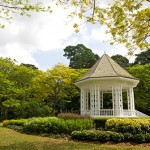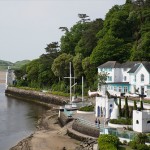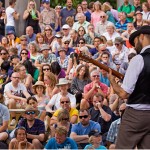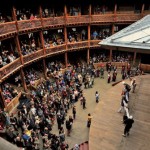Many of Englishmen in the past dwelled in cottages. They planted their cottage gardens with different types of herbs in a methodical manner. Most of these herbs they grew for medications. Apart from medicinal herbs, they grew vegetable and fruit plants. During the blooming and harvesting periods, every cottage garden dressed in bright hues of flowers and fruits provided the blessings of Mother Nature to these cottage dwellers.
With the arrival of Elizabethan period, prosperity reached the country in numerous ways, especially from discovering of new worlds. Cottage dwellers acquired enough assets in this era which changed their habit from growing plants for practical use, and began to plant for aesthetic purposes instead. More and more beautiful flowers and less and less medicinal and edible plants were grown around the cottages.
Almost every cottage garden smiled with flowering plants such as hollyhocks and violets taking the places of vegetable and fruit plants. Cottage gardening became an art from the 19th century. People started to deliberately grow plants around their cottages systematically from this century onwards. Many famous gardeners provided the necessary consultations in how to properly design their lands. William Robinson, Gertrude Jekyll, and Vita Sackville-west held prominence in this field as recognized expert gardeners.
Another two prominent gardeners, Myles Birkett Foster, and Helen Allingham provided gardening designs such as ‘Chocolate Box’ in the 19th century. Their designs gave prominence to having front gardens planted full of flower plants. The middle class in the era of Queen Victoria mostly lived in small cottages. So they used to design their cottages in such a way that provided enough space for their dwellings as well as for their plantations.
Today, cottages boast of having numerous plants. They include flower plants as well as herbs. They also grow vegetable and fruit plants. They prefer using the traditional system of fertilizing plants and trees and gardening designs that have an affinity to that of an ancient way of living. They do not like planting using modern ways that show boisterous lifestyles.
An outstanding form that the present day cottagers use when they design their gardens is in the style of the cottage of Thomas Hardy. Thomas Hardy was born in 1840 and lived in a thatched cottage. Later he came to live in Max Gate, which he designed in Victorian style. According to historical facts, this garden had a lot of vegetable and fruit plants. In later years, he preferred growing a range of flower plants in his front yard which the present day cottage dwellers prefer to replicate very much.
Many of cottages today keep beehives. There is evidence that Hardy had kept hives in his orchard. A cottage garden with a lot of flower plants is just the place for bees. Someone who enters a traditionally designed cottage garden nowadays will feel very much akin to the ancient way of living. To see an ideal example of present day authentic garden designing, one must pay a visit to the Hill Top garden of Beatrice Potter, the famous author. Visitors will surely recall paintings of cottage gardens drawn by the famous painter Helen Allingham as they enter Hill Top Orchard.
Another marvel of cottage gardening is Hidcote Manor in Hidcote Bartrim, Gloucestershire. Even though this location is quite vast, it has a series of tiny garden enclosures that visitors can take into account when they design their cottage gardens. Hedges and bushes, flora and fauna, as well as little parasites of plants that seek ways to breathe, planted in patches of cottages and brick layouts, are in fact an inspiration for modern cottage dwellers to redesign their gardens anew.









